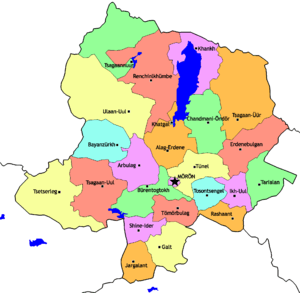Dukhan language
The Dukha or Dukhan language is an endangered Turkic variety spoken by approximately five hundred people of the Dukhan (a.k.a. Tsaatan) people in the Tsagaan-Nuur county of Khövsgöl Province in northern Mongolia. Dukhan belongs to the Taiga subgroup of Sayan Turkic (which also includes Tuvan and Tofa).[1] This language is nearly extinct and secondary use only. The ISO 639-3 proposal (request) code was dkh,[2] but was rejected.[3]
| Dukha | |
|---|---|
| Tsaatan | |
| тyъha тыл Tuha tıl | |
| Native to | Mongolia |
| Region | Khövsgöl Province |
| Ethnicity | Dukha |
Native speakers | 500[1] |
| Language codes | |
| ISO 639-3 | None (mis) |
| Glottolog | None |
It is mostly related to the speech of Soyot of Buryatia.[4] Also, it is related to the speech of Tozhu Tuvans and Tofa language. Today, used mixing together with Mongolian.[5]
Dukhan morphophonemic units are written with capital letters, similar to its sister languages and standard grammars[1]

Origin
The Dukha language or Dukhan is an endangered Turkic language. It is spoken by about five hundred people of the Dukhan (also Tsaatan) from the Tsagaan-Nuur County, Tsagaannurr (Khovsgol) Mongolia. Цагааннуур сум) is a Sum (district) of Mongolia in the province of Khovsgol, located in Northern Mongolia.
Classification of the Turkic Languages
| Proto-Turkic | Common Turkic | Siberia | Northern Siberia |
| |
| Southern Siberia | Southern Siberia | ||||
| Old Turkish |
| ||||
| Lower Chulym |
| ||||
| Altai Turkic[9] |
| ||||
Current Situation
Currently, The Dukhan language is mainly related to the amalgam of dialects from the nomadic people of Inner Mongolia, China, Russia, and surrounding areas.
- Buryat is a Mongolian language spoken in Russia, in the republic of Buryatia, and by smaller populations in Mongolia and China, in the East of Inner Mongolia. It is the language of the Buryats.
- The Tuvain (Or Tuvine Language, Tuvinian)[10] is a language of the family of Turkic languages spoken by nearly 200,000 Tuvans in the Republic of Tuva, Russia. Small groups speak Tuvain in Mongolia and China. The Tuvain contains many words borrowed from Mongolian and has been influenced by Russian over the last hundred years.
- Tofalar (or tofa, karagas) is a Turkic language spoken in the Ninjnewinsk region of the Irkutsk Oblast in Russia.
Bibliography
- Dolatkhah, Sohrab. 2016. Let's talk qashqay. In: "Let's talk" collection. Paris: The Harmattan.
- Dolatkhah, Sohrab. 2016. The qashqay: Turkic language of Iran. CreateSpace Independent Publishing Platform (online).
- Pierre-François Viguier, Elements of the Turkish language, or analytical tables of the usual Turkish language, with their development, dedicated to the King, under the auspices of M. The Comte de Choiseul-Gouffier, Ambassador of His Most Christian Majesty near the Ottoman Gate, by M. Viguier, Prefect Apostolic of the Establishments of the Congregation of the Mission in the Levant, Constantinople, from the Imprimerie du Palais de France, March 1790, in-4 °
References
- Elisabetta Ragagnin (2011), Dukhan, a Turkic Variety of Northern Mongolia, Description and Analysis, Harrassowitz Verlag, Wiesbaden
- Ted Bergman 2011. Request for New Language Code Element in ISO 639-3
- Comments received for ISO 639-3 Change Request 2011-057
- Endangered Languages of Indigenous Peoples of Siberia: The Soyot Language
- http://www.mnh.si.edu/press_office/annual_reports/annualreport2002/3_excel_science.pdf
- Deviating. Probably of South Siberian origin (Johanson 1998)
- Coene 2009, p. 75
- Coene 2009, p. 75
- Some dialects are close to Kirghiz (Johanson 1998)
- Roland Breton, Atlas des langues du monde, Éd. Autrement, 2003 ISBN 2-7467-0400-5